Climate Proofing Cities by Navigating Nature-Based Solutions in a Multi-Scale, Social–Ecological Urban Planning Context: A Case Study of Flood Protection in the City of Gothenburg, Sweden
Abstract
:1. Introduction
1.1. Theoretical Background
1.1.1. Nature-Based Solutions for Climate Proofing Cities
1.1.2. The Scale-Related Challenge of Integrating NBSs into Urban Planning
2. Case Study Background
2.1. The City of Gothenburg
2.2. Scales of Study Interest
2.2.1. Kärra-Skogome
2.2.2. Sub-Drainage Basin of Kärra-Skogome
2.2.3. The Västra Götaland Region
3. Materials and Methods
3.1. Quantifying the Water Run-Off Mitigation Potential Using the Urban Flood Risk Mitigation Model
3.2. Input Data to the UFRM Model
3.2.1. Curve Number Values
3.2.2. Reclassification of LULC Data
3.2.3. Reclassifying Hydrologic Soil Type to Hydrological Soil Groups
3.2.4. Rainfall Events and the Selection of Rainfall Depths
4. Results
4.1. Reclassifying Land Use/Land Cover
4.2. Reclassifying Hydrological Soil Type to Hydrological Soil Group
4.3. Curve Number Values
4.4. Rain Falls Depth
4.5. Quantifying the ES of Water Runoff
5. Discussion
5.1. The Importance of Assessments and Modelling
5.2. Pragmatic Urban Planning
6. Conclusions
Supplementary Materials
Author Contributions
Funding
Data Availability Statement
Acknowledgments
Conflicts of Interest
References
- Kabisch, N.; Frantzeskaki, N.; Pauleit, S.; Naumann, S.; Davis, M.; Artmann, M.; Haase, D.; Knapp, S.; Korn, H.; Stadler, J.; et al. Nature-Based Solutions to Climate Change Mitigation and Adaptation in Urban Areas: Perspectives on Indicators, Knowledge Gaps, Barriers, and Opportunities for Action. Ecol. Soc. 2016, 21, 26270403. [Google Scholar] [CrossRef]
- Pan, H.; Page, J.; Shi, R.; Cong, C.; Cai, Z.; Barthel, S.; Thollander, P.; Colding, J.; Kalantari, Z. Contribution of Prioritized Urban Nature-Based Solutions Allocation to Carbon Neutrality. Nat. Clim. Chang. 2023, 13, 862–870. [Google Scholar] [CrossRef]
- Dianat, H.; Wilkinson, S.; Williams, P.; Khatibi, H. Choosing a Holistic Urban Resilience Assessment Tool. Int. J. Disaster Risk Reduct. 2022, 71, 102789. [Google Scholar] [CrossRef]
- Sharifi, A.; Yamagata, Y. Resilience-Oriented Urban Planning. In Resilience-Oriented Urban Planning: Theoretical and Empirical Insights; Lecture Notes in Energy; Yamagata, Y., Sharifi, A., Eds.; Springer International Publishing: Cham, Switzerland, 2018; pp. 3–27. ISBN 978-3-319-75798-8. [Google Scholar]
- Colding, J.; Gren, Å.; Barthel, S. The Incremental Demise of Urban Green Spaces. Land 2020, 9, 162. [Google Scholar] [CrossRef]
- Natural Capital Project. Database of Publications Using InVEST and Other Natural Capital Project Software. 2023. Available online: https://doi.org/10.25740/bb284rg5424 (accessed on 6 April 2023).
- Brandt, S.A.; Lim, N.J.; Colding, J.; Barthel, S. Mapping Flood Risk Uncertainty Zones in Support of Urban Resilience Planning. Urban Plan. 2021, 6, 258–271. [Google Scholar] [CrossRef]
- Cao, W.; Zhou, Y.; Güneralp, B.; Li, X.; Zhao, K.; Zhang, H. Increasing Global Urban Exposure to Flooding: An Analysis of Long-Term Annual Dynamics. Sci. Total Environ. 2022, 817, 153012. [Google Scholar] [CrossRef] [PubMed]
- Kundzewicz, Z.W.; Pińskwar, I.; Brakenridge, G.R. Changes in River Flood Hazard in Europe: A Review. Hydrol. Res. 2017, 49, 294–302. [Google Scholar] [CrossRef]
- Kundzewicz, Z.W.; Pińskwar, I. Are Pluvial and Fluvial Floods on the Rise? Water 2022, 14, 2612. [Google Scholar] [CrossRef]
- Quagliolo, C.; Comino, E.; Pezzoli, A. Experimental Flash Floods Assessment Through Urban Flood Risk Mitigation (UFRM) Model: The Case Study of Ligurian Coastal Cities. Front. Water 2021, 3, 663378. [Google Scholar] [CrossRef]
- MacKinnon, M.; Pedersen Zari, M.; Brown, D.K.; Benavidez, R.; Jackson, B. Urban Biomimicry for Flood Mitigation Using an Ecosystem Service Assessment Tool in Central Wellington, New Zealand. Biomimetics 2023, 8, 9. [Google Scholar] [CrossRef]
- Vári, Á.; Kozma, Z.; Pataki, B.; Jolánkai, Z.; Kardos, M.; Decsi, B.; Pinke, Z.; Jolánkai, G.; Pásztor, L.; Condé, S.; et al. Disentangling the Ecosystem Service ‘Flood Regulation’: Mechanisms and Relevant Ecosystem Condition Characteristics. Ambio 2022, 51, 1855–1870. [Google Scholar] [CrossRef] [PubMed]
- Glosinska, E. Floodplain Management in the Context of Assessment and Changes of Flood Risk and the Environment—A Review. Pol. J. Environ. Stud. 2014, 23, 1895–1904. [Google Scholar]
- Peter, S.C. Reduction of CO2 to Chemicals and Fuels: A Solution to Global Warming and Energy Crisis. ACS Energy Lett. 2018, 3, 1557–1561. [Google Scholar] [CrossRef]
- Gómez-Baggethun, E.; Gren, Å.; Barton, D.N.; Langemeyer, J.; McPhearson, T.; O’farrell, P.; Andersson, E.; Hamstead, Z.; Kremer, P. Urban Ecosystem Services. In Urbanization, Biodiversity and Ecosystem Services: Challenges and Opportunities: A Global Assessment; Springer: Berlin/Heidelberg, Germany, 2013; pp. 175–251. [Google Scholar]
- Synthesis Report. Contribution of Working Groups I, II and III to the Sixth Assessment Report of the Intergovernmental Panel on Climate Change. 2023. Available online: https://climate-adapt.eea.europa.eu/en/metadata/publications/sixth-assessment-report (accessed on 26 December 2023).
- Potschin, M.; Haines-Young, R.; Fish, R.; Turner, R.K. Routledge Handbook of Ecosystem Services; Routledge: Abingdon, UK, 2016; ISBN 978-1-317-68704-7. [Google Scholar]
- Beitnes, S.S.; Kopainsky, B.; Potthoff, K. Climate Change Adaptation Processes Seen through a Resilience Lens: Norwegian Farmers’ Handling of the Dry Summer of 2018. Environ. Sci. Policy 2022, 133, 146–154. [Google Scholar] [CrossRef]
- Manes, S.; Vale, M.M.; Malecha, A.; Pires, A.P.F. Nature-Based Solutions Promote Climate Change Adaptation Safeguarding Ecosystem Services. Ecosyst. Serv. 2022, 55, 101439. [Google Scholar] [CrossRef]
- Sellberg, M.M.; Ryan, P.; Borgström, S.T.; Norström, A.V.; Peterson, G.D. From Resilience Thinking to Resilience Planning: Lessons from Practice. J. Environ. Manag. 2018, 217, 906–918. [Google Scholar] [CrossRef] [PubMed]
- Intergovernmental Science-Policy Platform on Biodiversity and Ecosystem Services (IPBES). IPBES Global Assessment Summary for Policymakers; IPBES: Bonn, Germany, 2019. [Google Scholar]
- United Nations Environment Programme. Nature-Based Solutions for Climate Change Mitigation. Nairobi and Gland. 2021. Available online: https://wedocs.unep.org/xmlui/bitstream/handle/20.500.11822/37318/NBSCCM.pdf (accessed on 13 April 2023).
- Andersson, E.; Grimm, N.B.; Lewis, J.A.; Redman, C.R.; Barthel, S.; Colding, J.; Elmivist, T. Urban Climate Resilience through Hybrid Infrastructure. Curr. Opin. Environ. Sustain. 2022, 55, 101158. [Google Scholar] [CrossRef]
- Schaubroeck, T. ‘Nature-Based Solutions’ Is the Latest Green Jargon That Means More than You Might Think. Nature 2017, 541, 133–134. [Google Scholar]
- European Environment Agency. Nature-Based Solutions in Europe Policy, Knowledge and Practice for Climate Change Adaptation and Disaster Risk Reduction 2021. Available online: https://www.eea.europa.eu/publications/nature-based-solutions-in-europe (accessed on 13 April 2023).
- Dumitru, A. Evaluating the Impact of Nature-Based Solutions: A Summary for Policy Makers; Publications Office of the European Union: Luxembourg, 2021; ISBN 978-92-76-40746-1. [Google Scholar]
- European Commission. Directorate General for Research and Innovation. Communication from the Commission to the European Parliament, the Council, the European Economic and Social Committee and the Committee of the Regions on European Missions; Publications Office: Luxembourg, 2021. [Google Scholar]
- Andersson-Sköld, Y.; Klingberg, J.; Gunnarsson, B.; Cullinane, K.; Gustafsson, I.; Hedblom, M.; Knez, I.; Lindberg, F.; Ode Sang, Å.; Pleijel, H.; et al. A Framework for Assessing Urban Greenery’s Effects and Valuing Its Ecosystem Services. J. Environ. Manag. 2018, 205, 274–285. [Google Scholar] [CrossRef]
- Jansson, Å.; Nohrstedt, P. Carbon Sinks and Human Freshwater Dependence in Stockholm County. Ecol. Econ. 2001, 39, 361–370. [Google Scholar] [CrossRef]
- Jansson, Å.; Folke, C.; Rockström, J.; Gordon, L.; Falkenmark, M. Linking Freshwater Flows and Ecosystem Services Appropriated by People: The Case of the Baltic Sea Drainage Basin. Ecosystems 1999, 2, 351–366. [Google Scholar] [CrossRef]
- Jansson, Å.; Colding, J. Tradeoffs between Environmental Goals and Urban Development: The Case of Nitrogen Load from the Stockholm County to the Baltic Sea. Ambi 2007, 36, 650–656. [Google Scholar] [CrossRef]
- Cimburova, Z.; Berghauser Pont, M. Location Matters. A Systematic Review of Spatial Contextual Factors Mediating Ecosystem Services of Urban Trees. Ecosyst. Serv. 2021, 50, 101296. [Google Scholar] [CrossRef]
- Boverket 2023. Behov av Bostadsbyggande 2022–2030. Available online: https://www.boverket.se/sv/samhallsplanering/bostadsmarknad/bostadsmarknaden/behov-av-bostadsbyggande/behov-2023/ (accessed on 10 April 2023).
- Statistikmyndigheten SCB 2022. Ökad Andel Boende i Tätorter. 2022. Available online: https://www.scb.se/hitta-statistik/sverige-i-siffror/miljo/tatorter-i-sverige/ (accessed on 17 April 2023).
- Göteborgs Stad 2021. Göteborgs Stads Miljö- och Klimatprogram 2021–2030. Available online: https://goteborg.se/wps/portal/start/kommun-och-politik/sa-arbetar-goteborgs-stad-med/hallbarhet-och-agenda-2030/program-och-planer-for-miljo-och-klimat/miljo--och-klimatprogram-for-goteborgs-stad-2021-2030 (accessed on 11 April 2023).
- Länsstyrelsen Västra Götaland. Bostadsmarknadsanalys 2022 Västra Götalands Län. 2022. Available online: https://catalog.lansstyrelsen.se/store/13/resource/2681 (accessed on 5 May 2023).
- Göteborgs Stad. Översiktsplan för Göteborg—Tematiskt Tillägg för Översvämningsrisker. 2019. Available online: https://goteborg.se/wps/wcm/connect/505ba586-d99d-4abc-8bc8-3473dd28002a/Tematisk+tillägg+ÖP+översvämningsrisk.pdf?MOD=AJPERES (accessed on 5 May 2023).
- Norlén, G.; Randall, L.; Sánchez Gassen, N.; Tapia, C.; Bogason, Á.; Cuadrado, A.; Heleniak, T.; Jokinen, J.C.; Karlsdóttir, A.; Lundgren, A.; et al. State of the Nordic Region 2022; Nordregio: Stockholm, Sweden, 2022. [Google Scholar]
- Göteborgs Stad. Stadsbyggnadskontoret. Förprövningsrapport Planbesked för bostäder vid Lerbäcksvägen (Skogome 8:13) inom stadsdelen Skogome, dnr 0354/19. Available online: http://www5.goteborg.se/prod/Intraservice/Namndhandlingar/SamrumPortal.nsf/93ec9160f537fa30c12572aa004b6c1a/48d9d189638ef143c12586db0053fca2/$FILE/2%20Forprovningsrapport.pdf (accessed on 5 May 2023).
- Västra Götalandsregionen 2021. Regional Development Strategy for Västra Götaland 2021–2030. Available online: https://www.vgregion.se/en/regional-development/ (accessed on 10 May 2023).
- Johnson, J.A.; Baldos, U.L.; Corong, E.; Hertel, T.; Polasky, S.; Cervigni, R.; Roxburgh, T.; Ruta, G.; Salemi, C.; Thakrar, S. Investing in Nature Can Improve Equity and Economic Returns. Proc. Natl. Acad. Sci. USA 2023, 120, e2220401120. [Google Scholar] [CrossRef] [PubMed]
- Burkhard, B.; Maes, J. Mapping Ecosystem Services. Adv. Books 2017, 1, e12837. [Google Scholar]
- Stanford University. Natural Capital Project, Urban Flood Risk Mitigation Model. 2023. Available online: https://naturalcapitalproject.stanford.edu/invest/urban-flood-risk-mitigation (accessed on 15 May 2023).
- Kadaverugu, A.; Nageshwar Rao, C.; Viswanadh, G.K. Quantification of Flood Mitigation Services by Urban Green Spaces Using InVEST Model: A Case Study of Hyderabad City, India. Model. Earth Syst. Environ. 2021, 7, 589–602. [Google Scholar] [CrossRef]
- Hamel, P.; Guerry, A.D.; Polasky, S.; Han, B.; Douglass, J.A.; Hamann, M.; Janke, B.; Kuiper, J.J.; Levrel, H.; Liu, H.; et al. Mapping the Benefits of Nature in Cities with the InVEST Software. Npj Urban Sustain 2021, 1, 25. [Google Scholar] [CrossRef]
- Liu, Y.; Xu, Y.; Zhao, Y.; Long, Y. Using SWAT Model to Assess the Impacts of Land Use and Climate Changes on Flood in the Upper Weihe River, China. Water 2022, 14, 2098. [Google Scholar] [CrossRef]
- Logsdon, R.A.; Chaubey, I. A Quantitative Approach to Evaluating Ecosystem Services. Ecol. Model. 2013, 257, 57–65. [Google Scholar] [CrossRef]
- Stürck, J.; Poortinga, A.; Verburg, P.H. Mapping Ecosystem Services: The Supply and Demand of Flood Regulation Services in Europe. Ecol. Indic. 2014, 38, 198–211. [Google Scholar] [CrossRef]
- United States Department of Agriculture. Chapter 9: Hydrologic Soil-Cover Complexes. In Part 630 National Engineering Handbook 2004. Available online: https://damtoolbox.org/wiki/National_Engineering_Handbook:_Chapter_9_-_Hydrologic_Soil-Cover_Complexes (accessed on 15 May 2023).
- Leena, K.; Barton, N.D.; Laura, C.; Pekka, H.; Marion, K.; Tin-Yu, L. Urban Experimental Ecosystem Accounting Pilot in the Nordic Cities; Nordic Council of Ministers: Copenhagen, Denmark, 2022; ISBN 978-92-893-7453-8. [Google Scholar]
- Naturvårdsverket. Nationella Marktäckedata (NMD) 2023. Available online: https://www.naturvardsverket.se/verktyg-och-tjanster/kartor-och-karttjanster/nationella-marktackedata/ (accessed on 9 May 2023).
- United Nations. Office for Outer Space Affairs UN-SPIDER Knowledge Portal. Step by Step: Flood Hazard Mapping. 2023. Available online: https://www.un-spider.org/advisory-support/recommended-practices/recommended-practice-flood-hazard-mapping/step-by-step (accessed on 10 May 2023).
- Sveriges Geologiska Undersökning. SGUs Symbolsamling För Jordarter. 2023. Available online: https://www.sgu.se/globalassets/produkter/kartor/symbolsamling_jordarter_ny.pdf (accessed on 9 May 2023).
- Nilsson, J. Hur Påverkar en Övergång från Konventionell Plöjning till Reducerad Jordbearbetning Avrinning från Åkermark; 2018; Department of Earth Sciences, Uppsala University. Available online: https://www.diva-portal.org/smash/get/diva2:1273266/FULLTEXT01.pdf (accessed on 15 May 2023).
- United States Department of Agriculture. Chapter 7. Hydrologic Soil Groups. In Part 630 Hydrology National Engineering Handbook. 2007. Available online: https://directives.sc.egov.usda.gov/22526.wba (accessed on 15 May 2023).
- Olsson, J.; Berg, P.; Eronn, A.; Simonsson, L.; Södling, J.; Wern, L.; Yang, W. Extremregn i nuvarande och framtida klimat Analyser av observationer och framtidsscenarier. Climatology 2018, 47, 367. [Google Scholar]
- Bennett, J.R.; Sisson, D.R.; Smol, J.P.; Cumming, B.F.; Possingham, H.P.; Buckley, Y.M. Optimizing Taxonomic Resolution and Sampling Effort to Design Cost-Effective Ecological Models for Environmental Assessment. J. Appl. Ecol. 2014, 51, 1722–1732. [Google Scholar] [CrossRef]
- McGinnis, M.D. Polycentric Governance and Development: Readings from the Workshop in Political Theory and Policy Analysis; University of Michigan Press: Ann Arbor, MI, USA, 1999; ISBN 978-0-472-08623-8. [Google Scholar]
- Derudder, B.; Meijers, E.; Harrison, J.; Hoyler, M.; Liu, X. Polycentric Urban Regions: Conceptualization, Identification and Implications. Reg. Stud. 2022, 56, 1–6. [Google Scholar] [CrossRef]
- Colding, J.; Marcus, L.; Barthel, S. Promoting Partnership between Urban Design and Urban Ecology through Social-Ecological Resilience Building. In Urban Transition—Perspectives on Urban Systems and Environments; IntechOpen: London, UK, 2021. [Google Scholar]
- Stanford University. Natural Capital Project, The InVEST Habitat Quality Model. Available online: https://naturalcapitalproject.stanford.edu/invest/habitat-quality (accessed on 20 May 2023).
- Marcus, L.; Pont, M.B.; Barthel, S. Towards a Socio-Ecological Spatial Morphology: A Joint Network Approach to Urban Form and Landscape Ecology. Urban Morphol. 2020, 24, 21–34. [Google Scholar] [CrossRef]
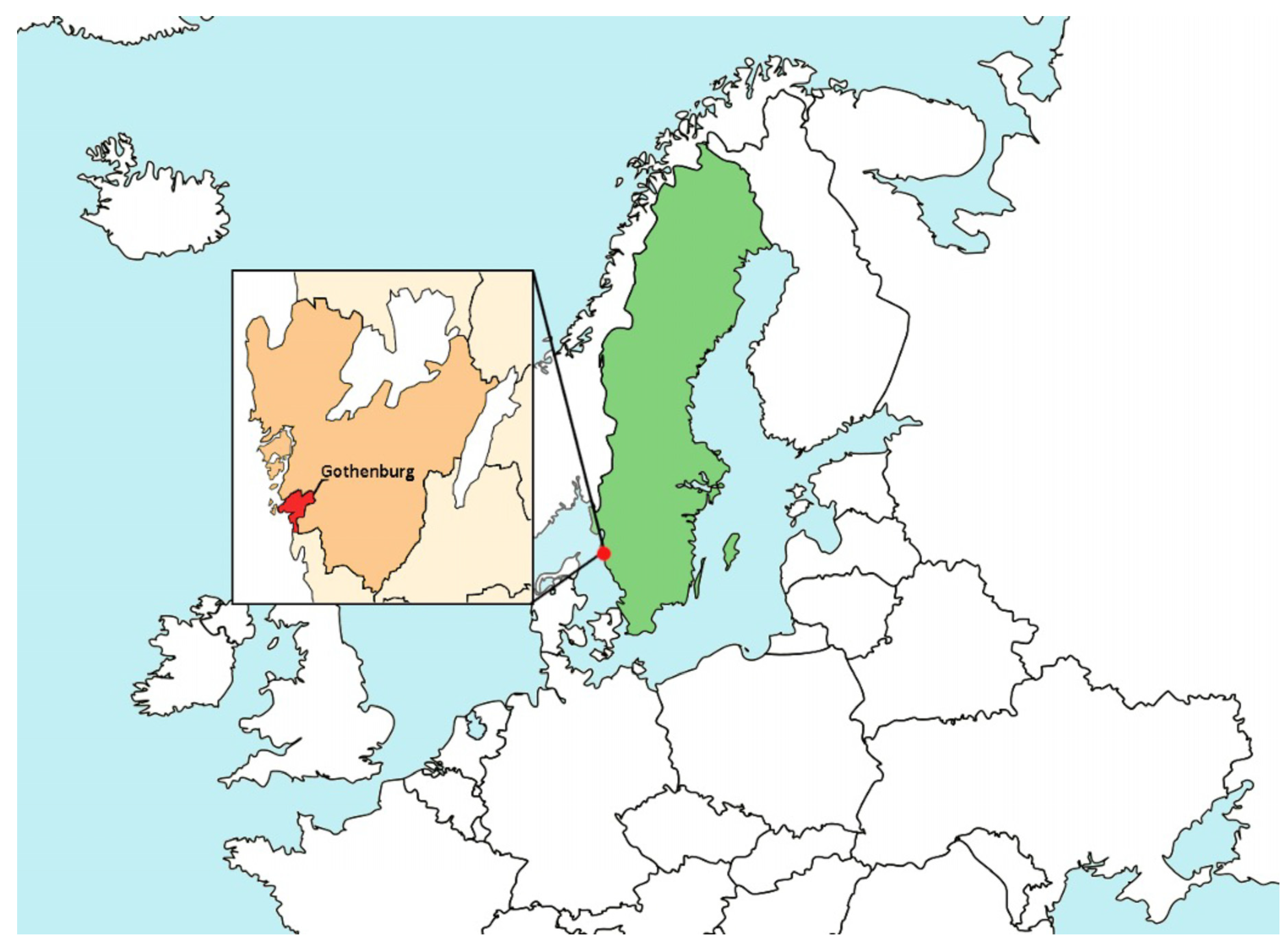
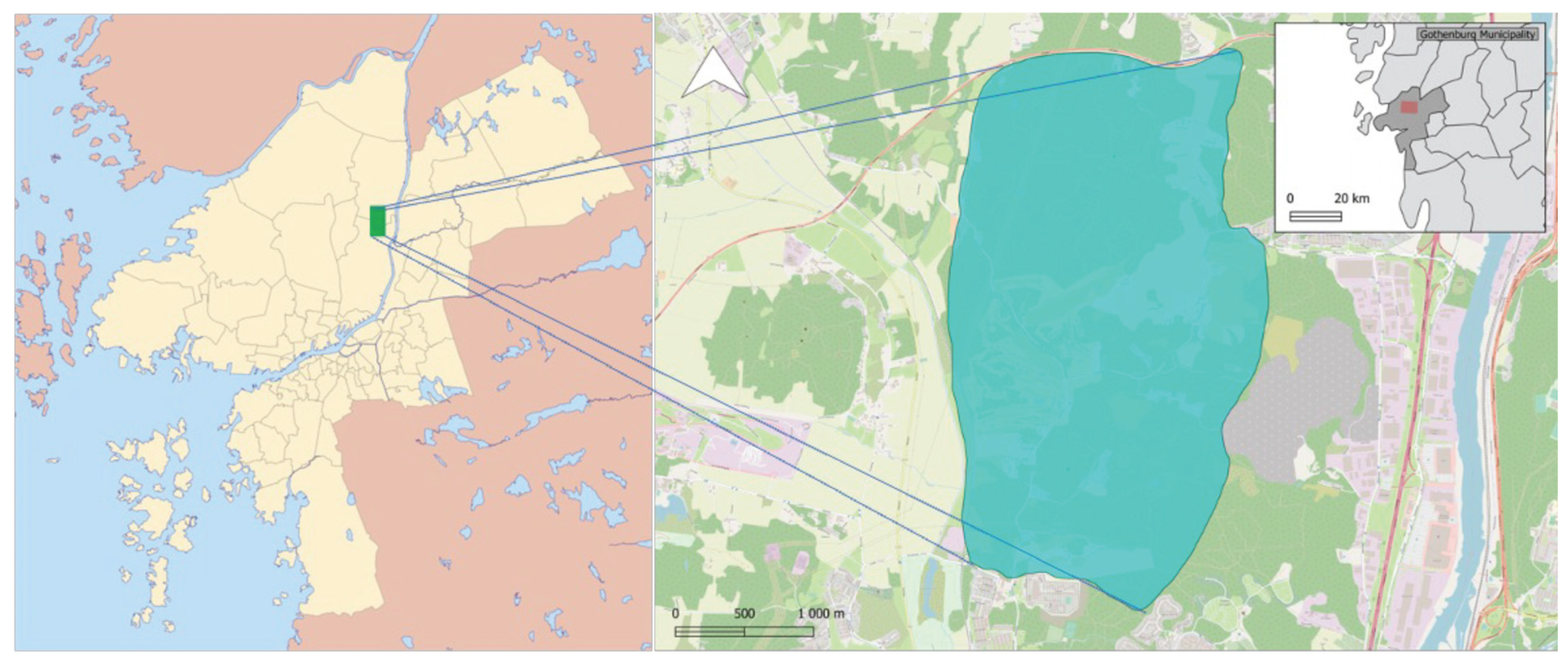


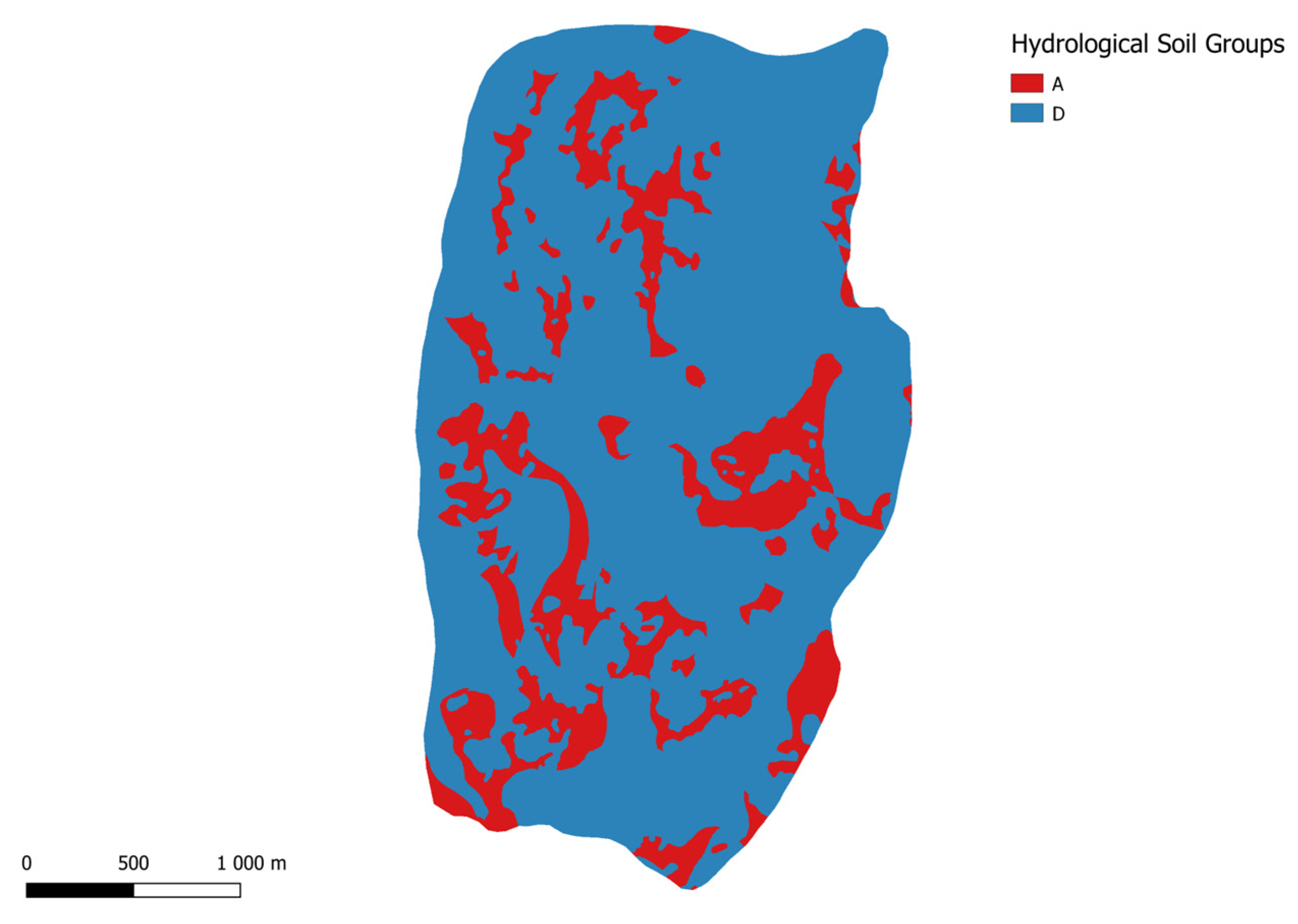
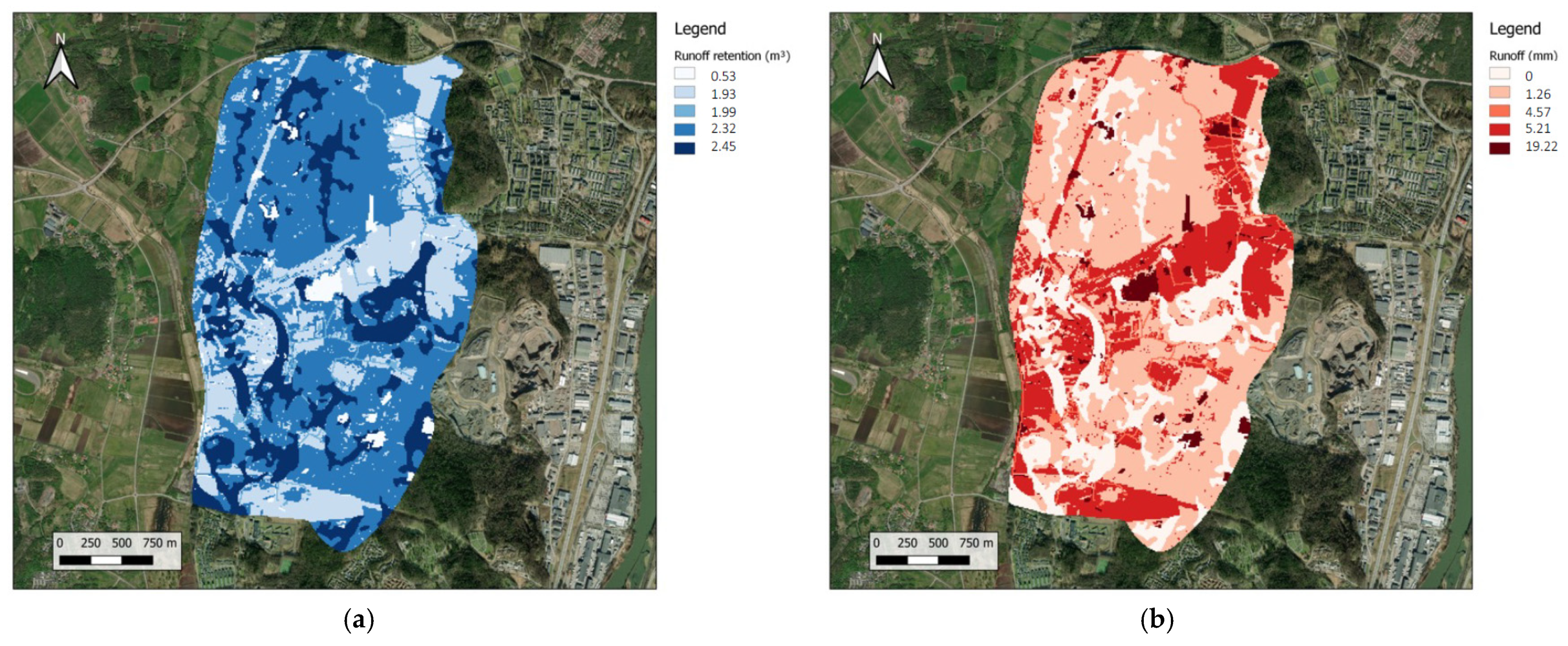
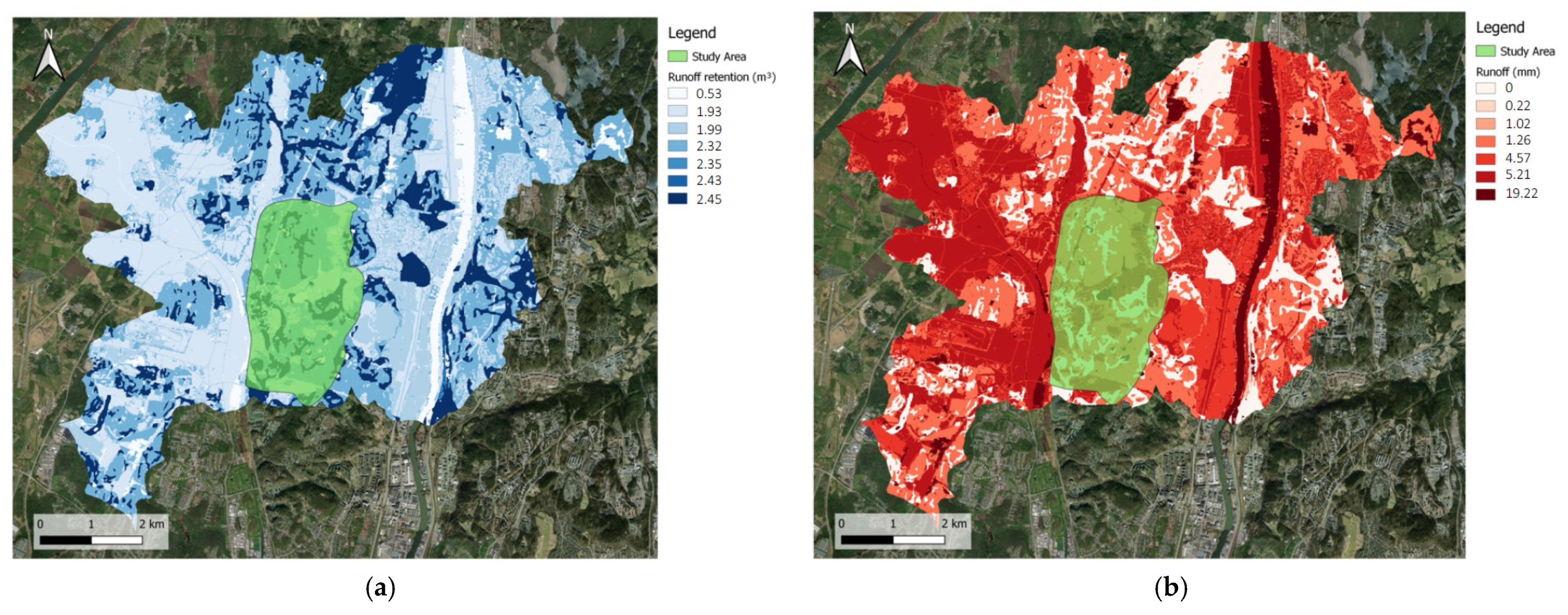

| Data | Format (Unit/Scale) | Spatial Resolution | Source |
|---|---|---|---|
| Area of interest a | vector | 25 m | Authors |
| LULC b | raster | 10 m | Naturvårdsverket |
| Hydrologic soil group | raster | 25 m | SGU |
| Curve number values | constant | N/A | NRCS |
| Rainfall depth | mm | 24.5–54.2 mm | SMHI |
| LU a ID | LU Description | Hydrologic Soil Group | |||
|---|---|---|---|---|---|
| A | B | C | D | ||
| 1 | Water | 100 | 100 | 100 | 100 |
| 2 | Medium residential | 57 | 72 | 81 | 86 |
| 3 | Forest | 30 | 58 | 71 | 78 |
| 4 | Agricultural | 67 | 77 | 83 | 87 |
| Rainfall Event | Climate Factor | |
|---|---|---|
| CF 0 | CF 1.15 | |
| 10 yr, 1 h | 24.5 mm | 28.2 mm |
| 100 yr, 1 h | 45.2 mm | 52.0 mm |
| Area of Interest | Rain Event (mm) | Average RRI a | RRV b (m3) | RV c (m3) | RRV/Area (m3ha−1) | RV/Area (m3ha−1) |
|---|---|---|---|---|---|---|
| Study area | 24.5 | 0.89 | 160,370 | 19,230 | 219 | 26 |
| 28.2 | 0.87 | 179,032 | 27,691 | 244 | 38 | |
| 45.2 | 0.76 | 250,483 | 80,860 | 342 | 110 | |
| 52.0 | 0.72 | 274,231 | 106,961 | 374 | 146 | |
| Sub-basins | 24.5 | 0.85 | 1,225,771 | 221,449 | 208 | 37 |
| 28.2 | 0.82 | 1,359,453 | 306,327 | 230 | 52 | |
| 45.2 | 0.70 | 1,861,114 | 808,859 | 315 | 137 | |
| 52.0 | 0.66 | 2,024,395 | 1,047,256 | 343 | 177 | |
| Region | 24.5 | 0.82 | 504,910,859 | 110,428,242 | 201 | 44 |
| 28.2 | 0.80 | 565,600,428 | 142,667,468 | 225 | 57 | |
| 45.2 | 0.71 | 806,169,243 | 329,068,570 | 321 | 131 | |
| 52.0 | 0.68 | 888,463,565 | 417,562,245 | 354 | 166 |
Disclaimer/Publisher’s Note: The statements, opinions and data contained in all publications are solely those of the individual author(s) and contributor(s) and not of MDPI and/or the editor(s). MDPI and/or the editor(s) disclaim responsibility for any injury to people or property resulting from any ideas, methods, instructions or products referred to in the content. |
© 2024 by the authors. Licensee MDPI, Basel, Switzerland. This article is an open access article distributed under the terms and conditions of the Creative Commons Attribution (CC BY) license (https://creativecommons.org/licenses/by/4.0/).
Share and Cite
Egegård, C.H.; Lindborg, M.; Gren, Å.; Marcus, L.; Pont, M.B.; Colding, J. Climate Proofing Cities by Navigating Nature-Based Solutions in a Multi-Scale, Social–Ecological Urban Planning Context: A Case Study of Flood Protection in the City of Gothenburg, Sweden. Land 2024, 13, 143. https://doi.org/10.3390/land13020143
Egegård CH, Lindborg M, Gren Å, Marcus L, Pont MB, Colding J. Climate Proofing Cities by Navigating Nature-Based Solutions in a Multi-Scale, Social–Ecological Urban Planning Context: A Case Study of Flood Protection in the City of Gothenburg, Sweden. Land. 2024; 13(2):143. https://doi.org/10.3390/land13020143
Chicago/Turabian StyleEgegård, Colin Hultgren, Maja Lindborg, Åsa Gren, Lars Marcus, Meta Berghauser Pont, and Johan Colding. 2024. "Climate Proofing Cities by Navigating Nature-Based Solutions in a Multi-Scale, Social–Ecological Urban Planning Context: A Case Study of Flood Protection in the City of Gothenburg, Sweden" Land 13, no. 2: 143. https://doi.org/10.3390/land13020143







